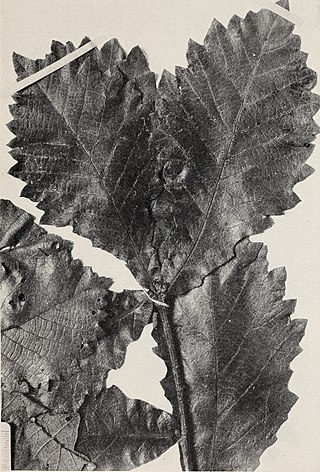Martín Sessé y Lacasta was a Spanish botanist, who relocated to New Spain during the 18th century to study and classify the flora of the territory. The standard author abbreviation Sessé is used to indicate this person as the author when citing a botanical name.
Pinus praetermissa, commonly known as McVaugh's pine, is a species of conifer in the family Pinaceae. Originally classified as a variety of Pinus oocarpa in 1909, it was promoted to specific status in 1990 after further study.

Rogers McVaugh was a research professor of botany and the UNC Herbarium's curator of Mexican plants. He was also Adjunct Research Scientist of the Hunt Institute in Carnegie Mellon University and a Professor Emeritus of botany in the University of Michigan, Ann Arbor.

Quercus rugosa, commonly known as the netleaf oak, is a broad-leaved tree in the beech and oak family Fagaceae. It is native to southern North America.
Berberis chochoco is an evergreen shrub or small tree up to 9 m (30 ft) tall, in the genus Berberis, family Berberidaceae. It is native to mountainous regions of northeastern Mexico, in the states of Nuevo León, Veracruz, and San Luis Potosí.

Ternstroemia lineata is a plant species native to high elevations in central Mexico. Many publications call this T. pringlei, but more recent publications confirm that the correct name is T. lineata.
Iresine heterophylla, or Standley's bloodleaf, is a plant species native to the southwestern United States and also to Mexico. It has been collected from Arizona, New Mexico, Texas, Chihuahua, Sonora, Durango, Coahuila, Nuevo León, Campeche and Tabasco.
Diastatea is a genus of plants native to Latin America, mostly in Mexico and Central America but with one species extending southward along the Andes to Argentina.
- Diastatea costaricensisMcVaugh - Guatemala, Honduras, Nicaragua, Costa Rica
- Diastatea expansaMcVaugh - central Mexico
- Diastatea ghiesbreghtii(Kuntze) E.Wimm - southwestern Mexico
- Diastatea micrantha(Kunth) McVaugh - widespread from central Mexico to the Jujuy region of northern Argentina
- Diastatea tenera(A.Gray) McVaugh - southern Mexico and Guatemala
- Diastatea virgataScheidw. - southern Mexico
Brickellia extranea is a Mexican species of flowering plants in the family Asteraceae. It is native to western Mexico in the state of Jalisco.
Brickellia magnifica is a Mexican species of flowering plants in the family Asteraceae. It is native to western Mexico in the states of Nayarit and Jalisco.
Carminatia recondita is a Mesoamerican species of annual plants in the family Asteraceae.
Carphochaete gummifera is a species of Mexican flowering plants in the family Asteraceae. They are native to Zacatecas in north-central Mexico.
Chromolaena misella is a Mexican species of flowering shrub in the family Asteraceae. It is native to the State of Jalisco in western Mexico.
Galinsoga mollis is a rare Mexican species of flowering plant in the family Asteraceae. It has been found only in the State of Jalisco in western Mexico.
Arbutus occidentalis or the Mexican Madrone is a small tree species in the heath family, that is endemic to Mexico. It is only known from a few areas in Western Mexico where it grows on rocky slopes. It produces red edible berries that are valuable food to wildlife.

Quercus crassifolia is a species of oak. It is widespread in Mexico from Sonora and Chihuahua to Veracruz and Chiapas. It has also been found in Guatemala.

Quercus peduncularis is an oak native to Mexico and Central America, ranging from Jalisco to Honduras.
Quercus mexicana is a species of oak. It is widespread in eastern Mexico from Chiapas to Tamaulipas.
Quercus microphylla is a Mexican species of oak in the beech family. It is widespread from Oaxaca as far north as Chihuahua, Coahuila, and Tamaulipas.
Jose Cuatrecasas Medal for Excellence in Tropical Botany was initiated in 2001 by the Smithsonian National Museum of Natural History, USA. It is named after José Cuatrecasas, a pioneering botanist and taxonomist who worked on the flora of tropical South America. It is awarded annually to a scientist who has made a very significant contribution to advancing the field of tropical botany. Nominations for the award can be made by all in the Botany Department at the museum.




